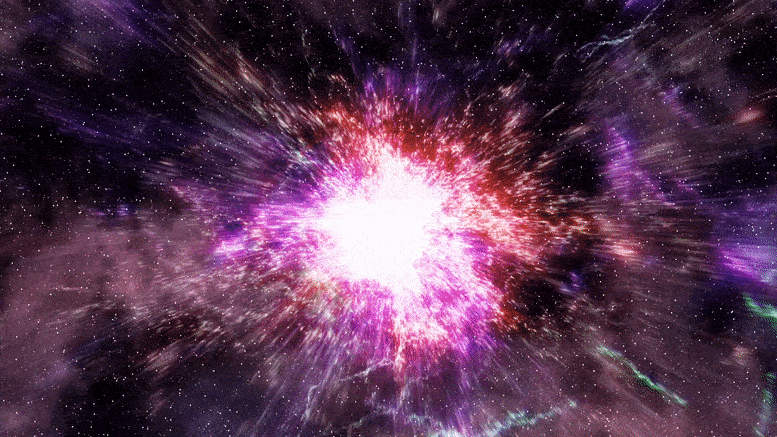<span class="glossaryLink" aria-describedby="tt" data-cmtooltip="
” data-gt-translate-attributes=”[{” attribute=””>NASA’s Nancy Gracy Roman Space Telescope won’t launch until 2027, and it won’t start operating until some time after that. But that isn’t stopping excited scientists from dreaming about their new toy and all it will do. Who can blame them?
A new study examines the Roman Space Telescope’s power in detail to see if it can help us answer one of our most significant questions about the Universe. The question?
Will the Universe keep expanding and tear itself apart in a Big Rip?
NASA hasn’t finalized the Roman Telescope’s mission design yet. There’s still room to tweak things, and this study is an effort to explore how they might tweak it for best results.
The study is “The High Latitude Spectroscopic Survey on the Nancy Grace Roman Space Telescope,” published in The Astrophysical Journal. The lead author is Yun Wang, a senior research scientist at Caltech/IPAC in Pasadena, California. The Roman Telescope will have multiple tools in its toolbox, and this study focuses on spectroscopy and how it’ll map the historic expansion of the Universe.
“Our study forecasts the science Roman’s spectroscopy survey will enable and shows how various adjustments could optimize its design,” said lead author Wang.
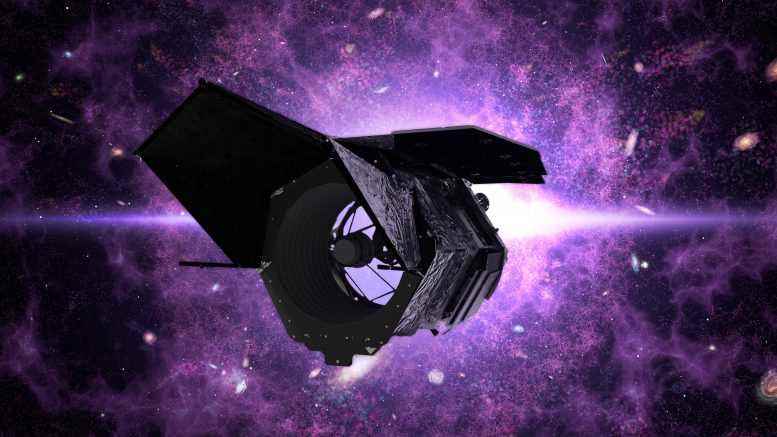
NASA’s Wide-Field Infrared Survey Telescope (WFIRST) is now named the Nancy Grace Roman Space Telescope, after NASA’s first Chief of Astronomy. Credit: NASA
The Roman will conduct a High Latitude Wide Area Survey (HLWAS). The High Latitude Spectroscopic Survey (HLSS) is the spectroscopic part of the HLWAS outlined in this study. The HLWAS is one of the telescope’s featured science objectives, along with novel approaches to exoplanet science. HLSS is a high-volume precision survey of millions of galaxies dating back billions of years. The Survey’s primary goal is to study universal expansion over the Universe’s history. The HLSS is so deep and wide that it’ll enable science that isn’t possible with other existing telescopes.
“While this survey is designed to explore cosmic acceleration, it will also offer clues about many other tantalizing mysteries,” said Wang. “It will help us understand the first generation of galaxies, allow us to map dark matter, and even reveal information about structures that are much closer to home, right in our local group of galaxies.”
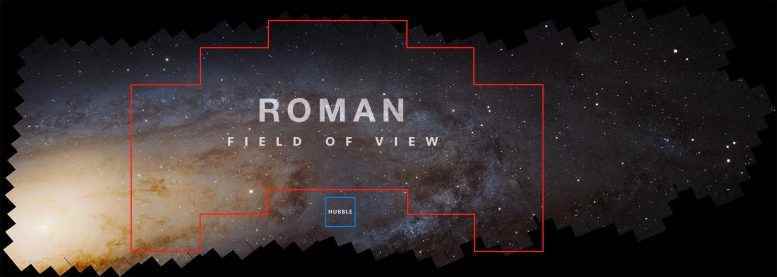
The Roman Space Telescope’s field of view will dwarf the Hubble’s. (No disrespect to the venerable Hubble, The Bringer of Knowledge.) Credit: NASA/GSFC/JPL
Roman’s HLSS relates to Universal expansion, Dark Energy, and Einstein’s Theory of General Relativity (TGR). Obviously, those are all deep and detailed topics, and they won’t fit in a Kurzgesagt-sized nutshell, but here’s how they fit together.
In 1915, when Einstein first put forth his TGR, nobody thought the Universe was expanding. TGR succeeded in explaining things Newtonian Gravity couldn’t. But it had a flaw. Einstein himself realized that his theory predicted that a static Universe was unstable, and it either has to expand or contract to be stable. But he rejected that, and he tripped himself up by introducing the now-notorious ‘cosmological constant’ to compensate. He used it to counteract the effect of gravity and achieve a static Universe. Einstein later called this his greatest blunder.
Then in the 1920s, astronomers discovered that the Universe is expanding. Bye-bye cosmological constant. American astronomer Edwin Hubble played a prominent role in the discovery, and the rule describing the expansion is called Hubble’s Law. (Sidebar: Belgian scientist and priest Georges Lemaître did earlier work on expansion, but he published his work in an obscure journal. Now Hubble’s Law is increasingly referred to as the Hubble–Lemaître law.) They discovered that galaxies are all moving away from each other, with only a very few exceptions. The Universe is expanding.
The expansion of the Universe was and is a mystery. Scientists have a placeholder name for the force that must be driving the expansion: Dark Energy.
For a long time, cosmologists thought the expansion was slowing. But it turns out that’s not true.
In 1998 scientists discovered that the Universe’s rate of expansion is accelerating. It shouldn’t be because the gravity from all the matter should slow the expansion down. With that discovery, the cosmological constant came back into play. It’s now the simplest explanation for the accelerating expansion. The cosmological constant is represented by the Greek capital letter lambda: Λ.
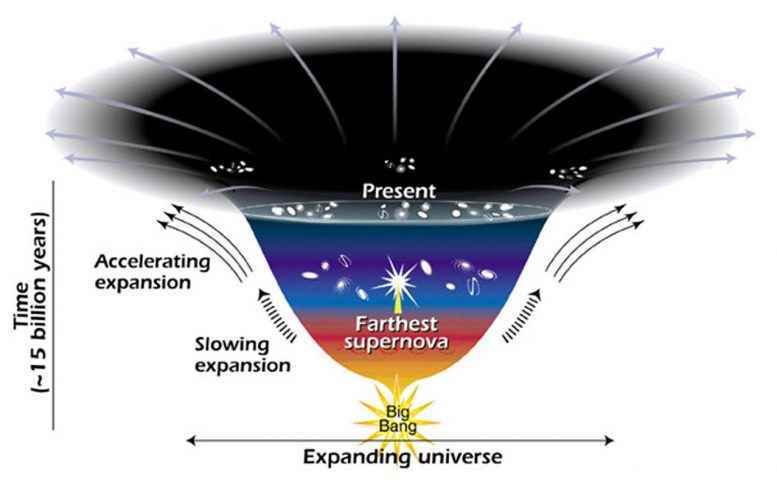
This image shows the expansion of the Universe accelerating. Time flows from bottom to top. Credit: Ann Feild (STScI)
Wouldn’t it be nice if the interminable guessing over the fate of the Universe was over? Wouldn’t it be fun to know how the Universe will end? (Lawrence Krauss thinks so.) It’d be as much fun as knowing what triggered its beginning. Imagine how popular you’d be at cocktail parties.
This brings us to the Roman Telescope and its High Latitude Spectroscopic Survey. The HLSS might be able to tell us about the future of the Universe’s expansion and if the Universe will continue to expand faster and faster and end in a Big Rip.
In their paper, the authors clarify the overall goal of the Survey. There are two top-level questions:
- Is cosmic acceleration caused by a new energy component or by the breakdown of general relativity (GR) on cosmological scales?
- If the cause is a new energy component, is its energy density constant in space and time, or has it evolved over the history of the universe?
There’s no magic to this. In a way, there’s brute force involved. The more of the Universe you can measure, and the more precisely you can measure it, the more accurate your conclusions are likely to be. This is behind the drive for larger, more precise telescopes like the Roman Space Telescope. The answers to our questions are more complex and harder to find.
In the paper, the authors present a reference design for the HLSS. The Roman’s HLSS will cover nearly 2,000 square degrees or about 5% of the sky in about seven months. This is a considerable improvement over other telescopes like the Hubble. “Right now, with telescopes like Hubble, we can sample tens of high-redshift galaxies. With Roman, we’ll be able to sample thousands,” explained Russell Ryan, an astronomer at STScI.
“Although Roman could execute a shallow and wide-area survey comparable to Euclid’s in approximately 1 yr of observing time, the deeper survey proposed here is a better complement to other surveys and more effectively exploits the capabilities of Roman’s larger aperture,” the paper states. “Per unit observing time, Roman is an extraordinarily efficient facility for slitless spectroscopic surveys, so it is well-positioned to respond to developments in experimental cosmology between now and mission launch in the mid-2020s.”
The new study shows that Roman’s HLSS should precisely measure 10 million galaxies from when the Universe was between three to six billion years old. Astronomers will use that data to map the large-scale structure of the Universe.
Kozmologlar zaten büyük ölçekli yapının haritasını çıkardılar, ancak Roma Teleskobu’nun HLSS’si bu haritalamayı bir adım daha ileri götürecek. HLSS bize Evrenin sadece iki ila üç milyar yaşında olduğu zamandan itibaren yaklaşık iki milyon galaksiye olan mesafeleri söyleyecektir. Bu daha önce hiç yapılmadı ve yeni veriler olacak.
Yapabildiğimiz kadar çok şeyi olabildiğince doğru bir şekilde ölçmek için kaynar. Roma Teleskobu, Evren’in zaman içindeki büyük ölçekli yapısını anlamamıza yeni bir derinlik ve genişlik getirebilirse, Evren’in genişleme tarihini anlayabiliriz. O zaman, belki sonunda cevabımızı alırız.
Yazarlar makalelerinde “Roman, karanlık enerji ve Einstein’ın yerçekiminde değişiklik de dahil olmak üzere görünürdeki hızlanan genişlemesinin olası açıklamalarını test etmek için evrenin genişleme tarihini belirleyecek” diye yazıyorlar. “Roman, karanlık enerji ve Einstein’ın yerçekiminde değişiklik de dahil olmak üzere görünürdeki hızlanan genişlemesinin olası açıklamalarını test etmek için evrendeki en büyük yapıların büyüme tarihini belirleyecek…”
Bu video, 55 saniyede tüm kırmızıya kayma küpleri koleksiyonu arasında çözülür. Evren genişledikçe, her bir küp içindeki galaksilerin yoğunluğu, ilk küpte 528.000’den son küpte 80’e düşer. Her bir küp yaklaşık 100 milyon ışıkyılı genişliğindedir. Muazzam boşluklarla ayrılmış geniş gaz şeritleri boyunca bir araya gelen galaksiler, günümüz Evreninde büyük kozmik ölçeklerde yankılanan köpük benzeri bir yapı. Bu görselleştirme, Evrenin şu anki 13,8 milyar yıllık yaşının %4 ila %43’ü arasında değişen farklı kozmik yaşlardaki simüle edilmiş gökadaların sayısını ve kümelenmesini gösterir. Her küp, kenar başına yaklaşık 100 milyon ışıkyılı olan sabit bir uzay hacmini temsil eder. Dizi boyunca, Evrenin genişlemesi, galaksilerin yoğunluğunu hızla düşürür. Her küp, 9’dan 1’e belirli bir kozmolojik kırmızıya kayma gösterir ve daha önceki küpler daha kırmızı tonlarda dökülür.
Bu son cümle şu anda nerede olduğumuzu açıklıyor. Evren genişliyor ve genişleme hızlanıyor. Durum böyle olmamalı, çünkü Evrendeki tüm maddenin yerçekimi bu genişlemeyi sürüklemelidir. Hızlanma, Einstein’ın yerçekimi teorisinin tam olarak doğru olmadığı anlamına gelir. Veya Evrene yeni bir enerji bileşeni eklememiz gerektiği anlamına gelir: Karanlık Enerji.
TGR’sinde açıklandığı gibi, Einstein’ın yerçekimi bir noktaya kadar doğrudur. Evrenin daha büyük kısımlarını gözlemleyene kadar Newton’unki de öyleydi. Newton’un yerçekimi, yerel ölçeklerde yerçekimi ile ne olduğunu doğru bir şekilde tanımlar ve Einstein’ın yerçekimi, daha da büyük bir ölçekte ne olduğunu doğru bir şekilde açıklar. Ama şimdi tüm Evrenle karşı karşıyayız ve anlayışımız yetersiz.
Bu çalışma, Romalının konuya getirebileceklerini simüle etmektedir. Roma Teleskobu’nun Evren’in geniş ve derin 3D görüntüleri, kozmik ivmeyi açıklamaya çalışan önde gelen teorileri ayırt etmek için yeni bir fırsat: değiştirilmiş bir yerçekimi teorisi veya Karanlık Enerji.
Bilim sadece kazanabilir. Her iki sonuç da bizi yaklaştırıyor.
Yazarlar, “Kozmik ivmenin bilinmeyen doğasını aydınlatırken, zamanın iki serbest işlevini ölçmemiz gerekiyor: kozmik genişleme tarihi ve büyük ölçekli yapının büyüme hızı” diye yazıyor yazarlar. “Bunlar bize karanlık enerjinin zamanla değişip değişmediğini ve bilinmeyen bir enerji bileşeni mi (örn.
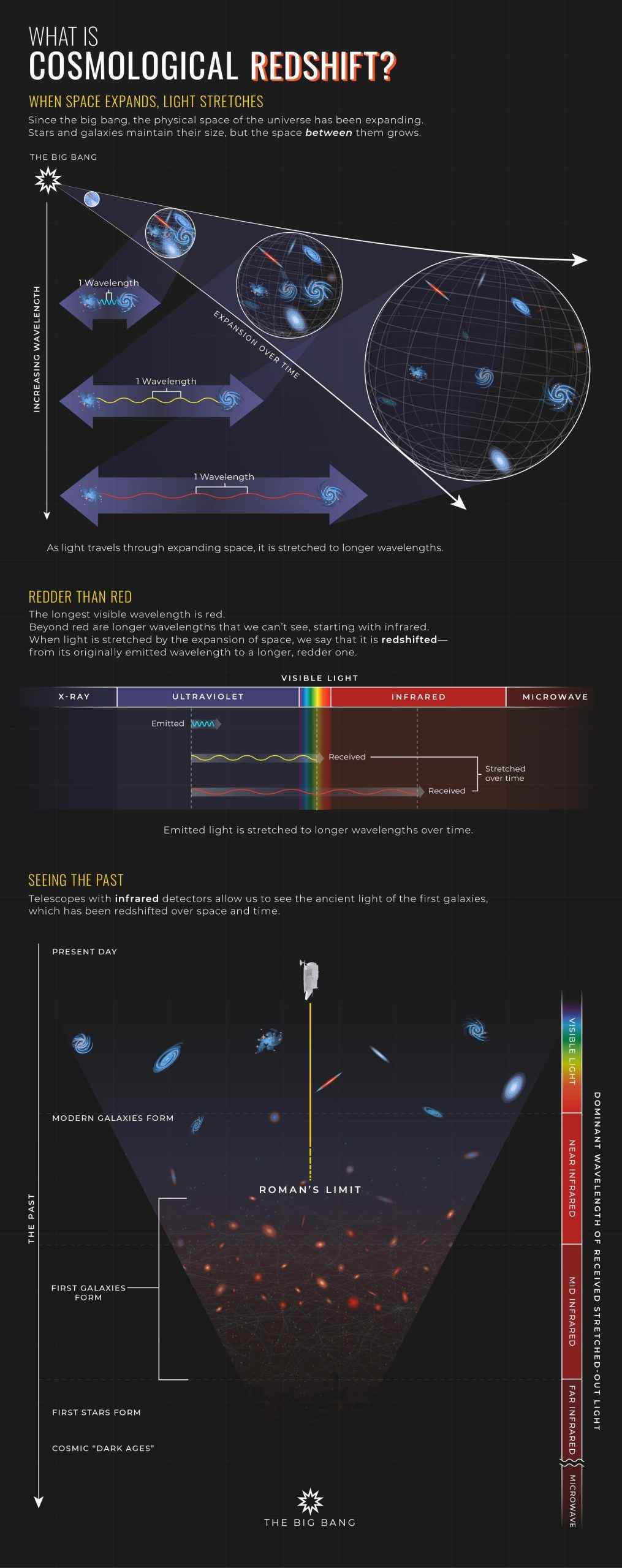
Bu grafik, kozmolojik kırmızıya kaymanın nasıl çalıştığını ve evrenin evrimi hakkında nasıl bilgi sunduğunu göstermektedir. Evren genişliyor ve bu genişleme uzayda seyahat eden ışığı uzatıyor. Ne kadar uzarsa, kırmızıya kayma o kadar büyük ve ışığın kat ettiği mesafe o kadar büyük olur. Sonuç olarak, ilk, en uzak galaksilerden gelen ışığı görmek için kızılötesi dedektörlü teleskoplara ihtiyacımız var. Kredi: NASA, ESA, Leah Hustak (STScI)
Wang, “Her iki durumda da yeni fiziği dört gözle bekleyebiliriz – kozmik ivmenin karanlık enerjiden kaynaklandığını öğrensek de, Einstein’ın yerçekimi teorisini değiştirmemiz gerektiğini de bulsak” dedi. “Roman her iki teoriyi de aynı anda test edecek.”
Yazarlar, referans HLSS’lerinin Roma’da Yüksek Enlem Geniş Alan Spektroskopik Araştırmasının nasıl uygulanabileceğinin bir örneği olduğuna dikkat çekiyor. “Roman’ın yürüteceği asıl anket, karanlık enerji projelerinin manzarası ve sinerjileri dikkate alınarak, piyasaya sürülmeden önce açık bir topluluk sürecinde tanımlanacak” diye yazıyorlar.
Evrenin nasıl sona ereceğini hiç bilebilecek miyiz? Belki bir gün yaparız ve kokteyllerde bunun hakkında sohbet ederiz. Ve Nancy Gracy Roman Uzay Teleskobu’nun cevabımızı bulmamıza nasıl yardımcı olduğu hakkında konuşabiliriz.
Orijinal olarak yayınlandı Bugün Evren.
Bu konu hakkında daha fazla bilgi için bkz. Dark Energy Vs. Değiştirilmiş Yerçekimi: NASA’nın Roma Misyonu, Rakip Kozmik İvme Teorilerini Test Edecek.

